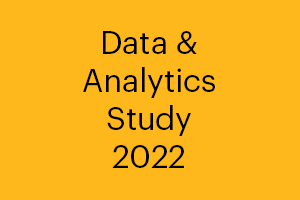Today, many organizations are pursuing data-driven projects to enhance their overall business strategies and to jumpstart their digital transformation journeys. In fact, data and analytics is among the top two technology initiatives expected to drive the most IT investment in 2022, according to the 2022 State of the CIO.
This year, Foundry conducted its 6th annual Data & Analytics Study to gain an understanding of the data-driven initiatives, investments, and challenges of IT decision-makers. Read on to learn more:
The current state of data and analytics
The majority (84%) of organizations have already implemented data-driven projects or have them on their future roadmaps. Deployment varies by company size – 92% of enterprise organizations (1,000+ company size) have data & analytics plans, compared to 79% at SMBs. There has also been clear growth since 2021 – today, 34% of IT decision-makers say their organization has already deployed data-driven projects and 21% are in the process of doing so or piloting. Last year these numbers were 28% and 27%.
How will the IT budget towards data-driven initiatives shift over the next 12-18 months? 55% of IT decision-makers said it will increase (up from 44% in 2021), 33% expect the budget allocation to remain the same, 8% are not sure, and only 4% expect a decrease. On average, organizations will spend $12.3 million on data-driven initiatives over the next 12 months.
What business goals are driving data-driven initiatives and an increase in investment? IT decision-makers hope to improve:
- Internal business process
- Customer insight and engagement
- Customer service/support
- IT operations
- Existing products
- Information security/cybersecurity
Increasing investments in data & analytics technology
Over three-quarters (77%) of IT decision-makers say their company has or is making the necessary investments in data and analytics technology it needs to compete in the marketplace. This is a major jump, and a good sign for the industry, as only 59% agreed to this statement last year.
Which AI and machine learning technologies and applications are on the radar of IT decision-makers today? The research shows:
Technologies
- Predictive analytics (54%)
- Anomaly detection (31%)
- Descriptive analytics (29%)
- Natural language processing (28%)
- Prescriptive analytics (24%)
Applications
- Process automation (50%)
- Decision support (35%)
- Customer analysis (33%)
- Virtual agents or chatbots (29%)
- Fraud detection (25%)
While 54% of the budget allocated to data & analytics is dedicated to technology, the other 46% is dedicated to people and skills. For example, acquiring new talent, development of existing talent, etc. Additionally, 72% agree that their company has or is making the necessary investments in data analytics skills it needs to compete in the marketplace. This is necessary as the lack of appropriate skill sets is the #1 challenge to achieving data-driven success.
Roadblocks in data-driven strategies & what IT leaders need from vendors
Along with skill sets inhibiting data-driven progress, the lack of a clearly defined data-driven strategy is also a main challenge for organizations. However, there is some good news as it dropped to the #2 challenge instead of the #1 challenge in 2021.
To get true benefits out of data-driven tools and solutions, the data must be collected, analyzed, and used properly. While there are some pain points around skills and data quality, 70% of IT decision-makers believe that their company is positioned well to capitalize on the data they collect and analyze. This does mean though, that 30% of organizations do not feel like they are positioned well, and most likely need some help from vendors.
To help IT decision-makers define, communicate, and execute their data-driven strategy, it’s important that vendors use a consultative approach and understand where organizations need advice and expertise. The study found that the top skill sets that are most in need are:
- Analytics training – e.g., for non-technical employees to use analytics (41%)
- Data management (39%)
- Data security (37%)
- Data integration (37%)
- Business intelligence (37%)
Taking this information into consideration can help you shape your approach with IT leaders and decision makers and to help them move forward with their data & analytics journey.
For additional information on data-driven initiatives, download the executive summary of the 2022 Data & Analytics research. And for a snapshot of the key points from the study, view our infographic here.






